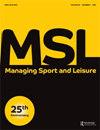检视台湾体育中心的健身app使用情况:将任务技术配合纳入技术准备接受模型
IF 1.8
Q3 MANAGEMENT
引用次数: 1
摘要
摘要理由/目的:本研究分析了用户使用健身应用程序的行为意向,并采用技术准备接受模型(TRAM)来探索技术准备(TR)和任务-技术适合(TTF)在使用健身应用软件的背景下的影响。设计/方法/方法:我们采用有目的的抽样方法,从台湾的六个民用体育中心招募了328名消费者,并进行了结构方程建模(SEM)进行数据分析。研究结果:研究结果提供了确凿的证据,证明TR与感知有用性(PU)和感知易用性(PEOU)均呈正相关,而TTF仅与PU呈正相关。该模型得到了验证,为现有的体育技术知识体系做出了贡献。实际意义:在技术应用的推广中,体育设施从业者可以针对特定的客户群体制定精确的营销策略。研究贡献:综合TRAM模型将智能技术的重点转移到消费者和体育环境的特征上,使研究模型更全面地预测用户对健身应用程序的意图,并优先使用体育相关技术来优化技术在体育领域的应用。本文章由计算机程序翻译,如有差异,请以英文原文为准。
Examining the use of fitness apps in sports centers in Taiwan: incorporating task–technology fit into a technology readiness acceptance model
ABSTRACT Rationale/purpose: This study analyzes users’ behavior intention to use fitness apps and adopts the technology readiness acceptance model (TRAM) to explore the effects of technology readiness (TR) and task–technology fit (TTF) in the context of using fitness apps. Design/methodology/approach: We used a purposive sampling method, recruiting 328 consumers from six civil sports centers in Taiwan, and performed structural equation modeling (SEM) for the data analysis. Findings: The results presented conclusive evidence that TR has a significant positive relationship with both perceived usefulness (PU) and perceived ease of use (PEOU), while TTF only has a significant relationship with PU. The model was validated, contributing to the existing body of knowledge on sports technologies. Practical Implications: In the promotion of technological applications, sports facility practitioners can target specific customer groups to develop precise marketing strategies. Research Contributions: The integrated TRAM model shifts the emphasis on intelligent technology to the feature of consumers and sports contexts, making the research model more comprehensive to predict users’ intention toward fitness apps and prioritize the use of sport-related technology to optimize the application of technologies in the sports fields.
求助全文
通过发布文献求助,成功后即可免费获取论文全文。
去求助
来源期刊

Managing Sport and Leisure
MANAGEMENT-
CiteScore
6.80
自引率
11.10%
发文量
62
期刊介绍:
Managing Sport and Leisure is a refereed journal that publishes high quality research articles to inform and stimulate discussions relevant to sport and leisure management globally. The journal is committed to publishing research that advances understanding of the practice of sport and leisure management in the public, voluntary and commercial sectors, internationally. It will appeal to anyone with a serious interest in contemporary sport and leisure management issues, including academics, managers, consultants, politicians and students. One of the key objectives of the journal is to provide a high level forum for communication between academics and practitioners of sport and leisure. Therefore Managing Sport and Leisure aims to be contemporary, integrated and, most importantly, relevant to practitioner training. Contributions are welcome and expected from both academics and practitioners throughout the international sport and leisure management community. In addition, the journal welcomes submissions from those investigating new and innovative areas of research and practice in sport and leisure management.
 求助内容:
求助内容: 应助结果提醒方式:
应助结果提醒方式:


